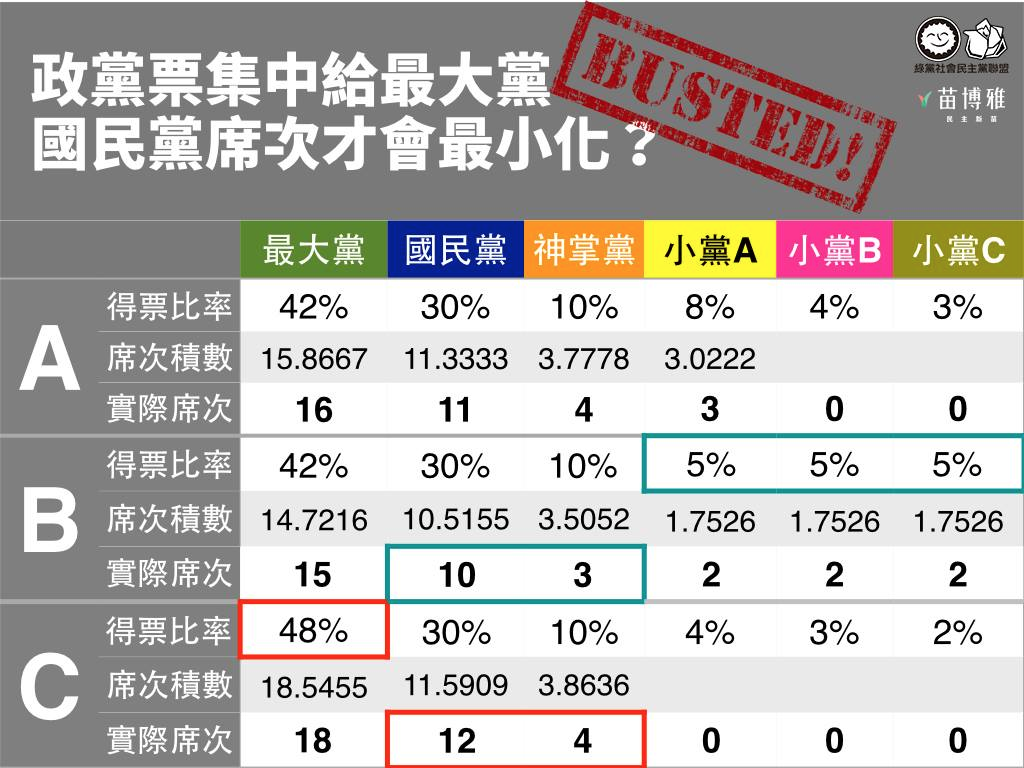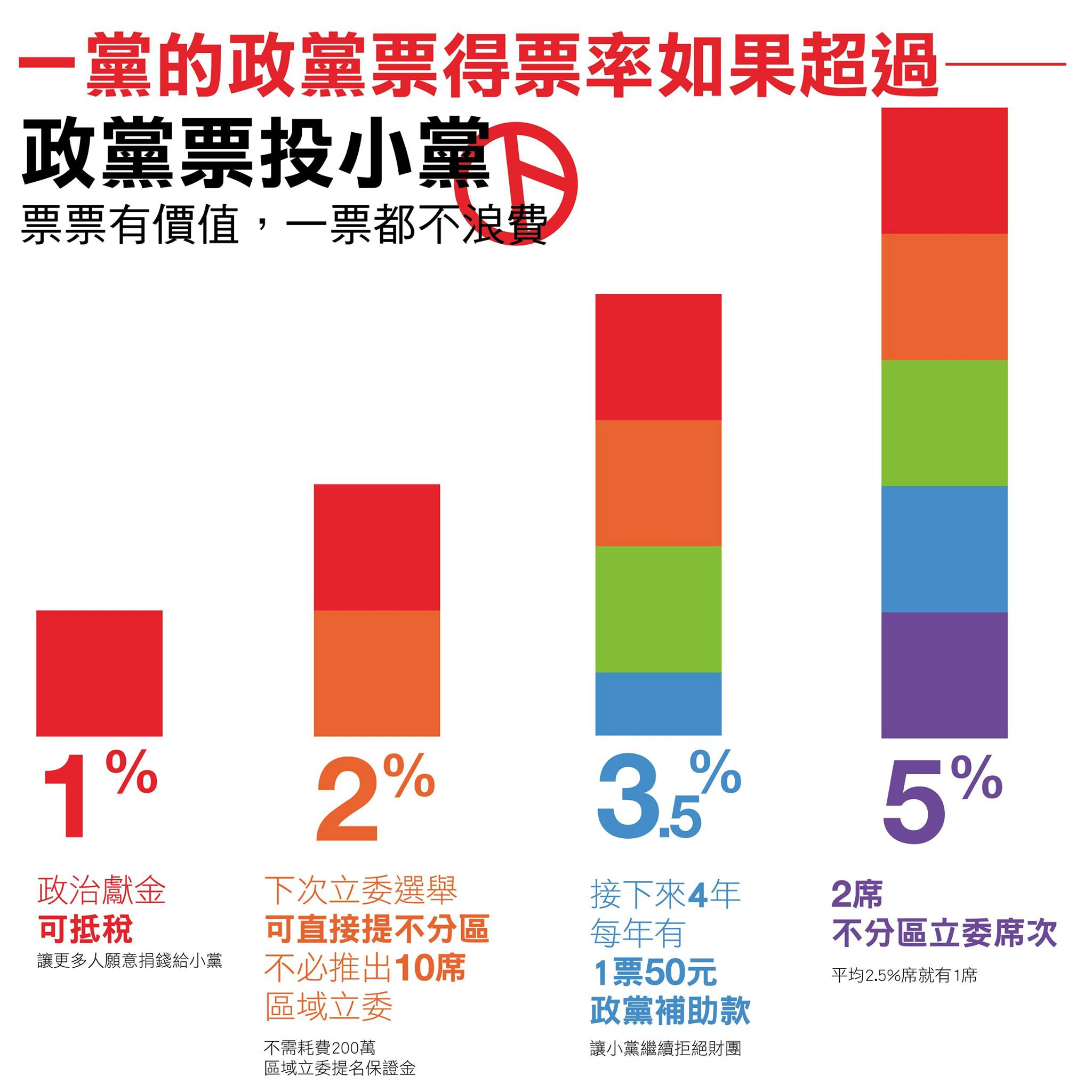It’s All About Strategic Voting
by Tumin
語言:
English
Photo Credit: People News
What Is the Whole Commotion About Party Votes?
IN THIS UPCOMING election, voters will be entitled three votes, namely the presidential, district, and the party vote. The presidential vote and district vote usually took precedence in past elections, but in this upcoming election, party votes seem to have taken the spotlight.
What exactly then is the party vote? The party vote largely decides the total number of seats each political party gets in the legislative. This ensure a more proportional representation of different political parties, at the same time, giving newer or smaller parties an opportunity to enter the legislative. In some sense, party votes allows for more diversity in the legislative. Due to the presence of many new, Third Force parties, such as the Social Democratic Party and Green Party Alliance, Free Taiwan Party, and the New Power Party, an interesting point of this year’s election will be seeing as to how voters would vote given an array of options. Moreover, most of these third party forces seem to come out of the wave of civic activism as a result of the Sunflower Movement, hence, most of its supporters are mainly the younger generation.
Brian Hioe has discussed how the third force parties and DPP seemed to have negotiated their terms out, showing support for each other during the race. However, it may be that the endorsement might mainly be coming from the DPP side, as neither third force parties has actually proclaimed themselves to be explicitly supportive of Tsai for presidency, even though it is in some sense extraneous to be explicit about that point at all. In fact, in recent controversy, Fan Yun, chairman of the SDP and Green Alliance, has faced controversy over hypocrisy for criticizing about the DPP on one hand, but still calling out for Tsai to endorse her. But that is not to say that the third party forces are exploiting Tsai’s popular image. Essentially, it may be that the DPP is capitalizing on the fact that since the youths are supportive of such Third Force parties, Tsai’s public endorsement of these candidates maybe boost her image among young people.
Such “generosity” on the part of the DPP may only go as far as endorsing district specific candidates. What seems to be a problem for the DPP now is that Tsai’s endorsement of various candidates from different parties has created a potential threat that may divide the party votes. In recent weeks, the DPP has been stressing through social media, rally events, and news for the need to “concentrate” the party votes on the DPP. The DPP is aware that most of the youth votes it “used” to receive will be split among the Third Force. Moreover, as we saw in the landslide victory of Ko over Sean Lien, is that the youth are gradually tired of the Blue and Green political divides in Taiwan, and hence have a tendency to voting for new candidates are parties unfettered by the Blue-Green rhetoric. This is not to mention, in the 2016 Presidential elections, we will be looking at an increase of 1.2 million first-time voters, a seemingly large number that is capable of swinging election results prospectively.
Casting aside who ought to have the most seats in the legislative, we might say that, if the purpose of this election is to vote as much KMT seats out of the office as possible, the DPP claiming the need to “concentrate” voting does have a logical fallacy.
Is What the DPP is Calling for Really Strategic in Ousting the KMT?
IN A RECENT attempt to debunk this “strategic voting” argument of the DPP, Miao Poya, currently running for District 8 of Taipei City, made a great chart showing how voting for the small parties would actually result in lesser seats for the KMT. One may look at this chart and assume that it is a straightforward statistical chart, but when looked closely, there are some political innuendos in it.
Conditions A, B, and C are examples of the number of legislative seats each party will received based on the outcome of the party votes. Here, there are three 6 parties, though represented by a different name, the colours used seem to refer to the different political parties respectively. It appears to be that under condition B, a more egalitarian distribution of the party votes among the small parties (小黨) would ensure the least number of the pan-blue seats. Here, Miao seemed to groups the KMT and the PFP, labelled as 神掌黨 together, seemingly indicating that they share common values and should be granted the least seats. Probably, this would suggest that both are pan-Blue. Unlike in condition C, which the DPP is calling out for, concentrating all votes would only mean that the KMT and PFP would be granted 16 seats altogether, instead of the lesser 13 seats. Furthermore, the smaller parties would be left with no party seats, meaning that the legislative will still be stuck between having the few usual parties.
 Photo credit: Miao Poya
Photo credit: Miao Poya
Of course, in this case, a sort of dilemma game occurs in which information asymmetry allows for the DPP to resort to threats and fear to get what it wants. Some may fear that even if they were to vote for the smaller parties, others may not vote for it, therefore, they would not reach the necessary benchmark of 5% to allow for their presence in the legislative. Thus, these votes would be seen as “wasted” and may end up granting the KMT more seats in the legislature. In the 2012 election, the DPP gained 35.4% of the party votes while the KMT gained 56.64% of the party votes. In the recent polls of the 2016 election, 27.7% of the votes goes to the DPP, 21% of the votes the KMT, 7.2% of the votes to the NPP, 4.8% of the votes to the PFP, 3.8% to the New Party, and 3.3% to the Social Democratic Party and Green Party Alliance. Therefore, it is no wonder that the DPP is antsy about this year’s party votes. However, it also goes to show that Taiwan is now stepping into an era of new politics no longer dominated by the Blues and Greens.
But what is so important about reaching the benchmark of 5%? We might look at that next.
What About the Five Percent?
THIS FOLLOWING chart shows the benefits a party would receive based on the different percentages of party votes they get in the upcoming election. If a party gets 1% of the party votes, political donations becomes tax deductable, allowing for more political donations for the parties. If party votes reaches 2%, in the next legislator elections, there is no mandatory requirement of pushing out 10 district candidates, and the party can directly run for election through the party lists. Here, the party will be able to save more money by not having to spend it on the electorate district participatory deposits.
If party votes reaches 3.5%, there will be a 50NTD subsidy for every vote a party receives in this upcoming election for the next 4 years until the next election.This allows for a continuous flow of funding, giving the smaller parties enough funds so they would not succumb to corporate financial influence. Lastly, if party votes reaches 5%, a party will be given two legislator-at-large seats, allowing for presence and decision-making say in the legislative.
 Photo credit: 葉立斌 | Knowing
Photo credit: 葉立斌 | Knowing
Hence, this is why party votes are given much weight in this year’s election. The party votes would seem to decide the fate of these new parties, and the possibility of Taiwan transitioning into a more diversified political environment. So what exactly is the more strategic way to vote?
Conclusion: Is there a Right Voting Strategy?
THE RACE IS on, and different voices are making different arguments on social media, with some calling for the concentration of votes for the DPP for strategic reasons, while others are calling for a diffusion of votes to the small parties
Is there a right voting strategy? Essentially it boils down to what exactly is a voter hoping to see in the legislative. If it is about ousting the party that has always been in majority out of the legislative, does it make sense to vote solely on the DPP if it will allow for them to become yet another KMT? If Taiwan is looking into diversifying its political environment, giving chances to new parties, and providing for various forms of checks and balances, then voting for the smaller parties would be the right choice in the long term.


 Photo credit: Miao Poya
Photo credit: Miao Poya Photo credit:
Photo credit: